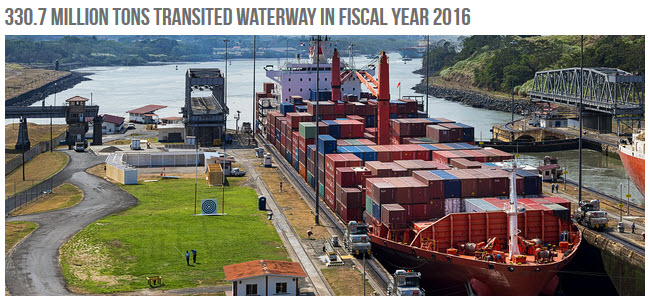At the close of the 2016 fiscal year, the Panama Canal Authority (ACP) recorded the third-highest annual tonnage in its history, welcoming 330.7 million Panama Canal tons (PC/UMS).
A total of 13,114 vessels transited the Panama Canal during the fiscal period from October 1, 2015 to September 30, 2016. Of these, 238 were neopanamax vessels that took advantage of the newly opened expanded canal during the first three months of its operation, accounting for 18.2 million PC/UMS.
“Despite the international shipping downturn this past year, we recorded one of the highest annual tonnage figures since the opening of the original canal 102 years ago,” said Panama Canal Administrator Jorge L. Quijano. “This latest success reinforces the continued strategic importance of the route and the growing value that recent investments in the canal will bring to the maritime industry.”
Expanded Panama Canal Inauguration
The past fiscal year saw a number of important milestones for the Panama Canal, the most significant of which was the June 26, 2016 inauguration of the expanded canal. A crowd of more than 30,000 witnessed the first transit of a neopanamax vessel, the COSCO Shipping Panama, through the new lane that doubled the canal’s cargo capacity. The event represented the culmination of more than nine years of construction and a renewed commitment by the Panama Canal to provide the maritime industry with the safest, most reliable and efficient service possible.
Since opening, the expanded canal has seen major liners redirect service to the waterway to take advantage of the route’s significant time savings. Thus far, nine neopanamax liner services have been deployed through the new locks, primarily on the U.S. East Coast-to-Asia trade route. Next month, an additional neopanamax liner service is expected to follow suit.
Performance by Segment
Analysis shows that the container segment continued to be the leading source of canal traffic, accounting for more than 36 percent of the total cargo received. In total, container vessels contributed 119.6 million PC/UMS transited through the waterway, including 13.4 million PC/UMS that passed through the expanded canal. The next leading segments by tonnage were bulk carriers (65.6 million PC/UMS), tankers (55.0 million PC/UMS), and vehicle carriers (46.7 million PC/UMS).
Another notable milestone was the introduction of the liquefied natural gas (LNG) segment during the final months of FY16. LNG carriers-which can now transit the waterway due to the expanded canal’s wider, longer and deeper locks-contributed 1.5 million PC/UMS and surpassed initial Panama Canal forecasts. The influx was also partially due to the unexpected emergence of U.S. shale production and the lifting of a 40-year-old ban, allowing the country to export oil for the first time in decades.
Other additions in FY16 were the first crude oil shipments to the canal via Aframax and Suezmax vessels. The ACP did not anticipate this segment to transit so early in the expanded canal’s infancy. However, the trend is one that has been received favorably and is expected to continue as the crude oil industry strengthens.
Positioning the Canal for the Future
In fiscal year 2017, the Panama Canal will continue its focus on enhancing the logistics infrastructure in Panama by advancing projects such as the Corozal Container Terminal, which is currently in the bidding stage. This infrastructure project, along with others, will add to the waterway’s already robust set of offerings for the maritime industry and further position Panama as the preferred route and regional destination for shippers.
“What we accomplished with the opening of the Expanded Panama Canal this past fiscal year was just the beginning of an ambitious plan to strengthen Panama’s position as the logistics hub of the Americas,” said Quijano. “Our greatest strategic asset is our geographic location at the crossroads of the Americas. We are a link in a chain where reliability is a most valued attribute, and we are committed to continue to enhance it.”

